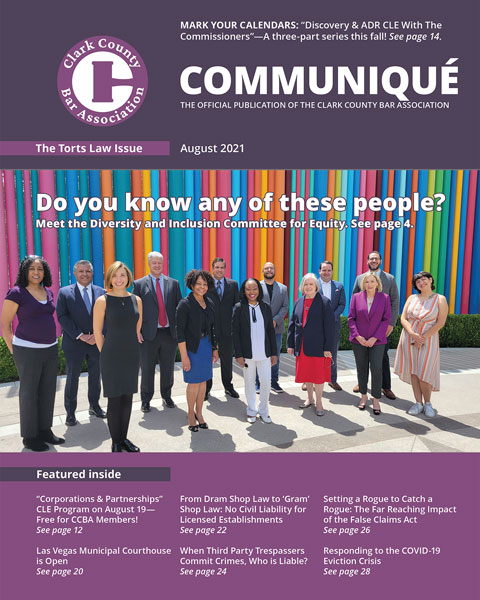When are property owners liable for criminal acts of a trespasser that occurred on their properties? There is substantial case law available to guide attorneys through cases stemming from a criminal act committed on a person’s property by an employee or other invitee (Rockwell v. Sun Harbor Budget Suites, 112 Nev. 1217 (1996), Wood v. Safeway, 121 Nev. 724 (2005), for example). But what about when the criminal act is committed by an unwelcome trespasser on the property? Property owners are commonly named in negligence-based lawsuits for such acts. The analyses of these cases must be fact specific.
Negligence cases stemming from a third-party trespasser’s criminal act hinge on a defendant’s breach of a duty to protect a victim from the trespasser’s criminal act. Generally, this duty exists if the criminal act was reasonably foreseeable: “[T]he duty element of a negligence cause of action must be determined as a matter of law by considering whether the wrongful act that precipitated the plaintiff’s injury was foreseeable.” Estate of Smith v. Mahoney’s Silver Nugget, Inc., 127 Nev. 855 (2011).
Foreseeability boils down to whether a defendant reasonably should have anticipated that a willful criminal act would occur on the property. If foreseeability is established, the question is whether the property owner should have taken action to prevent the event from occurring, thus providing the causal link between the breach of duty and the plaintiff’s injury. There is generally no duty to protect against a criminal act that is not reasonably foreseeable (see NRS 615.015).
When is a criminal act of a third-party trespasser considered reasonably foreseeable?
Three categories are helpful when determining whether a criminal act of a trespasser was foreseeable:
- Distance and Proximity of the Crime to the Property;
- Frequency of General Crime in the Area; and
- Past History of Similar Crimes.
Courts are more likely to find that a crime committed on-property was more foreseeable than one committed off-property. Indeed, the criminal actor in an “off-property” case may not be considered a trespasser if he was merely near the subject property. However, if the crime occurred in an area “sufficiently proximate” to the property, like a parking lot or neighboring building, that closeness can be enough to establish foreseeability. See Novikova v. Greenbriar Owners Corp., 694 N.Y.S.2d 445 (1999).
Had similar criminal activity occurred at/near the property before the crime? If so, courts are more likely to find foreseeability. For example, the United States Court of Appeals for the Ninth Circuit discussed a “prior similar acts test,” finding that a past history of violent fights at a city park was not sufficient to make a shooting that occurred there months later foreseeable. See McKown v. Simon Prop. Group, Inc., 689 F.3d 1086. A past of violent incidents alone may not be enough to establish foreseeability.
The mere existence of trespassers in an area that eventually becomes the crime scene in a negligence case is insufficient as a matter of law to find that a plaintiff’s injury at the hands of a subsequent trespasser was reasonably foreseeable. See Tompkins v. Union Pac. R.R., 2015 U.S. Dist. LEXIS 82210. Even knowledge that the same criminal trespasser who eventually committed the crime causing injury had previously trespassed in the area beforehand does not establish foreseeability. The presence of “nonthreatening transients” on the property is also insufficient to find foreseeability. McIntosh v. United States, 2008 U.S. Dist. LEXIS 80281.
Finally, how many prior, similar crimes must have been committed to establish foreseeability? In Anderson v. Mandalay Corp., 131 Nev. 825 (2015), a guest of a hotel was attacked inside her room by a hotel employee. The court found that evidence of five prior attacks on patrons at the hands of employees was sufficient to find a question of fact regarding foreseeability. While there is no hard-line number of prior, similar crimes necessary to support foreseeability, as few as five may be enough.
Establishing foreseeability is an issue of fact dependent on the precise facts of each case. The facts must establish a history of crimes committed by trespassers at or near the area of injury such that the criminal causation of injury to the plaintiff was reasonably foreseeable.
About the authors

Amanda Ebert, Esq. is an attorney in the Las Vegas office of Lipson Neilson. She focuses her practice on professional liability and insurance defense.

About this article: This article was originally published in the “Torts Law” issue of Communiqué, the official publication of the Clark County Bar Association, (August 2021). See https://clarkcountybar.org/about/member-benefits/communique-2021/communique-august-2021/.
© 2021 Clark County Bar Association (CCBA). All rights reserved. No reproduction of any portion of this issue is allowed without written permission from the publisher. Editorial policy available upon request.
